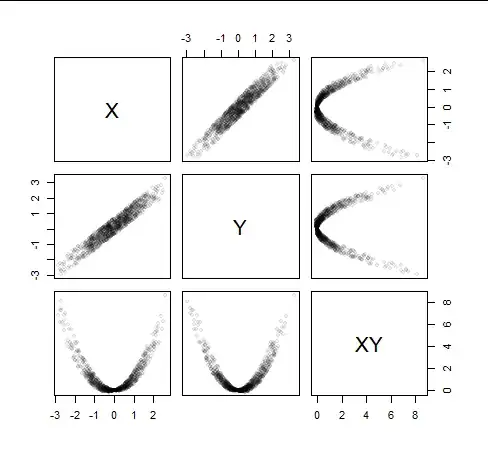I have a random variable $X.$ I want to find a random variable $Y$ such that $Y$ is correlated with $X,$ but $Y$ is not correlated with the product of $X$ and $Y.$ Is it always possible?
-
2When $E[X]=0$ it's always possible, because you can take $Y=X.$ – whuber Apr 18 '21 at 18:45
2 Answers
If $X=Y$ and Rademacher distributed, the product will be a constant and have zero covariance (uncorrelated) with $X$ or $Y$.
Is it always possible?
My previous example was incorrect.
- 49,700
- 3
- 39
- 75
-
2This answer rests on what seems like an incidental triviality: namely, that correlations with constant variables are undefined. It would be more insightful to replace "correlation" with "covariance" in the question. – whuber Apr 18 '21 at 18:47
-
@whuber I keep forgetting that. Edited, now my answer assumes covariance instead of correlation. – gunes Apr 18 '21 at 19:05
-
2Thanks -- but it is still appealing to the same extreme circumstance, and it doesn't answer the question. We are *given* $X$ (and to avoid trivialities let's assume it's non-constant) and are asked whether *there exists* a $Y.$ Simply exhibiting one $(X,Y)$ pair doesn't address that. – whuber Apr 18 '21 at 19:08
-
The confusion is because there are two questions. I've given Rademacher example to say Yes to the title question. But, my second sentence doesn't answer the current question unless it's modified (i.e. asking for non-zero covariance instead of non-zero correlation). – gunes Apr 18 '21 at 19:13
-
1I think we should take the body of the question to be an elaboration of the title question rather than a separate question. – whuber Apr 18 '21 at 19:15
-
Oh, I'd still be tempted to understand her/his first sentence as a rewording of the title question, e.g. because the OP says he/she wants to find that particular case, and the second sentence as a follow-up question. But, that still leaves half /maybe full of my post unguarded :) – gunes Apr 18 '21 at 19:19
-
Provided $X$ is non-degenerate (that is, it is not almost surely constant) and has finite variance (without which it's impossible to have any correlation), you can always find such a $Y.$
One method begins by taking any random variable $Y_0$ for which $E[Y_0]=0$ but $E[XY_0]\ne 0$ and $E[|X|\,Y_0^2] \lt \infty.$ There always exists such a variable when $X$ is non-constant. Rather than go into this technical detail, let's limit the analysis to random variables $X$ for which $E[|X|^3]$ is finite, where it's simple to construct a variable with these properties: just set $Y_0 = X-E[X].$ This guarantees $E[Y_0]=0.$ Calculate
$$E[XY_0] = E[X(X-E[X])] = E[X^2] - E[X]^2 = \operatorname{Var}(X)\ne 0$$
because $X$ is non-constant. Finally,
$$E[|X|\,Y_0^2] = E[|X|^3] - 2E[X]E[X\,|X|] + E[X]^2E[|X|] \lt \infty$$
is guaranteed by the power norm inequality.
Define
$$\eta = -\frac{E[XY_0^2]}{E[XY_0]}.$$
This number always exists because the denominator is nonzero, and the numerator is finite. Set
$$Y = Y_0 + \eta$$
and compute
$$\begin{aligned} E[Y] &= \eta\\ E[XY] &= E[XY_0] + \eta E[X]\\ E[XY^2] &= E[XY_0^2] + 2\eta E[XY_0] + \eta^2E[X]. \end{aligned}$$
Use these to find
$$\begin{aligned} \operatorname{Cov}(X,Y) &= E[XY] - E[X]E[Y] = E[XY_0]\ne 0 \text{ and}\\ \operatorname{Cov}(XY,Y) &= E[XY_0^2] + \eta E[XY_0] = 0 \end{aligned}$$
(due to the definition of $\eta:$ now you see where it came from!). The correlations are just scaled versions of these covariances, whence the correlation of $X$ and $Y$ is nonzero but the correlation of $XY$ and $Y$ is zero.
In practice it helps to add a tiny amount of noise to $Y_0:$ this will deal with the more difficult situations such as when $X$ has only two values and one of them is rare. As an example, I have added a little bit of uniform noise to a Normally generated $X$ and carried out the preceding construction (viewing the values as an empirical probability distribution). Here are the scatterplots:
It is clear what's going on: Because $Y$ parallels $X,$ $X$ and $Y$ are (strongly positively) correlated, as shown in the middle top and middle left panels. But because $Y$ has been suitably centered (that's the role of $\eta$), the relation between $Y$ and $XY$ is parabolic, with arms just balancing one another out to assure zero correlation: that is what the middle bottom and middle right panels show. (The other two panels in the upper right and lower left corners are irrelevant.)
This is the R code that generated the figure.
#
# Generate a random variable.
# (This is an empirical distribution).
#
# x <- rbinom(1e4, 1, 9/10) # A difficult test
x <- rnorm(1e3)
#
# Find Y.
#
eps <- diff(range(x)) * 1e-1
y <- x + runif(length(x), -eps, eps)
y <- y - mean(y)
eta <- -mean(x*y^2) / mean(x*y)
y <- y + eta
#
# Exhibit the correlation coefficients as a check.
#
zapsmall(c(`rho(x,y)`=cor(x,y), `rho(xy,y)`=cor(x*y, y)))
#
# Display the scatterplots.
#
pairs(cbind(X=x, Y=y, XY=x*y), pch=19, cex=.8, col="#00000010")
- 281,159
- 54
- 637
- 1,101
